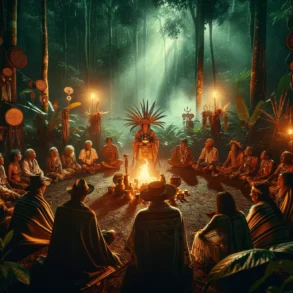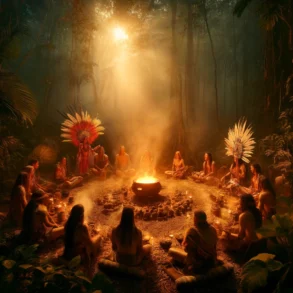Embark on a transformative journey as you explore “The Ayahuasca Ceremony: Healing And Visionary Journeys In Amazonian Tribes.” This thought-provoking article will guide you through the mesmerizing and seldom-tread path of Ayahuasca ceremonies – powerful ritualistic practices deep in the heart of the Amazon rainforest. Readers will gain in-depth understanding of the tribal customs, healing practices, and spiritual awakenings that these ceremonies evoke, offering a unique chance to peek into one of the world’s most enticing regions and its mystical traditions.

Historical Context of Ayahuasca
Ayahuasca, also known as the vine of the soul, has a deep-rooted cultural and spiritual significance that transcends decades.
Origins in Amazonia
The origins of Ayahuasca can be traced back to the indigenous tribes of the Amazon Basin. This intricate concoction is a blend of two plant species native to the rainforests of South America, Banisteriopsis caapi, and Psychotria viridis. These tribes recognized the sacredness of these plants and discovered that when brewed together, these plants would lead to profound hallucinogenic experiences.
Cultural Significance in Indigenous Tribes
For these indigenous societies, Ayahuasca is more than just a spiritual brew, it is a divine communion that brings clarity and knowledge. It is deeply weaved into their cultural fabric, used as a messenger between the physical and spiritual worlds, a tool for healing, and a conduit for obtaining wisdom from their ancestors. There is a considerable amount of reverence associated with Ayahuasca, and its use is often limited to sacred ceremonies led by experienced healers.
Propagation to Western Societies
In the past few decades, the mystical allure of Ayahuasca has extended far beyond the confines of the Amazon rainforest and piqued the interest of Western minds. Many thrill-seekers and spiritual enthusiasts are drawn to the allure of the transformative experiences associated with Ayahuasca ceremonies. As a result, Ayahuasca tourism has witnessed a significant surge, leading to an intersection of cultures and beliefs.
Preparation of the Ayahuasca Brew
The preparation of the potent Ayahuasca brew is a ceremonious process steeped in ancient traditions.
Ingredients and Proportions
The primary constituents of the Ayahuasca brew are the Banisteriopsis caapi vine and the leaves of the Psychotria viridis plant. The former provides the monoamine oxidase inhibitors (MAOIs) that allow the DMT in the latter to be orally active, paving the way for the vivid, dream-like state experienced during an Ayahuasca journey. The precise proportions can vary depending on the intended strength of the brew and the shaman’s preference.
Traditional Preparation Methods
The traditional method of preparing the Ayahuasca brew is a laborious task that requires hours of patient commitment. The vine and leaves are cleaned and pounded to a pulp, then boiled and simmered in water for several hours. This process is often repeated multiple times, with each cycle intensifying the potency of the brew.
Modern Brewing Techniques
In recent years, aided by modern equipment and advancements in herbal extraction techniques, Ayahuasca brew can also be prepared in more controlled environments. However, purists insist that the traditional method is not just about creating the drink, but a spiritual process that infuses the brew with the healing energy of the shaman.
The Ayahuasca Ceremony
The Ayahuasca ceremony is a highly structured, ceremonial event that is designed to allow participants to dive deep into their subconscious minds and confront their deepest fears and insecurities.
Step-by-step Ritual Process
The ritual typically begins with a cleansing ceremony known as La Dieta, in which participants refrain from certain foods and activities. The shaman then blesses the Ayahuasca before offering it to the participants. Once everyone has ingested the brew, the shaman initiates the journey with the help of invocations, sacred chants, or music.
Roles of Participants
Only those prepared to confront their deepest fears and insecurities should participate in an Ayahuasca ceremony. Participants are expected to maintain a respectful silence and allow the effects of the brew to take over.
Use of Music and Chants
A critical aspect of the Ayahuasca ceremony is the use of Icaros, traditional songs and chants sung by the shaman. These Icaros help guide the participants through their journey, and their rhythm and tone can actively shape the visions and experiences.
Role of the Shaman
The Shaman is the spiritual guide, the one who prepares the Ayahuasca and directs the spiritual journey.
Training and Preparation
Becoming a shaman requires extensive training under a skilled mentor and a deep understanding of plant medicines and healing methods. Instantly recognizable by their unique attire, many shamans have devoted their life to understanding the mystical properties of Ayahuasca.
Guiding the Spiritual Journey
During the Ayahuasca ceremony, the shaman anchors the ceremony, providing emotional and spiritual support. Using their intuitive understanding and relationship with the plant spirit, they assist the participants in navigating their internal landscapes and facing their hidden truths.
Dealing with Negative Reactions
An Ayahuasca journey can be intense and overwhelming for many, and it is the Shaman’s role to provide comfort and coax participants through these challenging moments. Through their guidance, Shamans can help turn challenging experiences into profound moments of self-realization.

Healing Properties of Ayahuasca
Ayahuasca is renowned for its multitude of healing properties, addressing physical, psychological, and spiritual ailments.
Physical Healing and Detoxification
Ayahuasca promotes physical healing by purging toxins and negative energies from the body. This purgative effect, accompanied by bouts of vomiting and diarrhea, is an essential part of the Ayahuasca healing process.
Psychological and Emotional Healing
Psychological healing is at the core of the Ayahuasca experience. The brew works in profound ways to address trauma, depression, addiction, and anxiety, providing insights that can lead to significant shifts in perspective and emotional liberation.
Spiritual Healing and Self-Discovery
Above all, Ayahuasca is a tool for spiritual healing and self-discovery. It can show one’s true self, shedding light on life purpose and personal truths often obscured by the busyness of day-to-day life.
Visionary Journeys and Spiritual Insights
The Ayahuasca experience is characterized by its visionary journeys and the profound spiritual insights that accompany them.
Typical Hallucinations and Visions
The potent combination of substances in Ayahuasca induces a visionary state where vivid, often symbolic, hallucinations are commonly experienced. These visions often relate to personal experiences, fears, desires, and spiritual beliefs.
Interpreting the Ayahuasca Experience
Interpretation of one’s Ayahuasca experience is an intensely personal process. The visions and hallucinations are often metaphoric and symbolic, providing insights that are uniquely suited to the individual’s journey and struggles.
Personal Transformation and Enlightenment
The lasting impact of an Ayahuasca journey often eases the mind from past traumas and encourages personal transformation and enlightenment. It invites individuals to see the world from a new perspective, illuminating a path towards increased compassion, clarity, and self-love.
Scientific Study of Ayahuasca
In recent years, the scientific community has begun to investigate the profound effects of Ayahuasca.
Biological and Neurological Effects
Research suggests that Ayahuasca has significant effects on the brain’s neural circuits, particularly those associated with memory, emotional regulation, and introspection. It is believed to stimulate the release of certain neurotransmitters such as serotonin, creating the powerful visionary experiences characteristic of an Ayahuasca journey.
Potential Therapeutic Uses
There is increasing evidence that Ayahuasca may have potential therapeutic uses. Preliminary research hints at its effectiveness in treating various mental health conditions, including depression, anxiety and post-traumatic stress disorder (PTSD).
Controversies and Criticisms
However, the use of Ayahuasca is not without its controversies and criticisms. Advocates argue that the therapeutic potential of Ayahuasca should be more widely acknowledged, while skeptics express concerns about the safety and ethics of its use, particularly among vulnerable populations.
Safety and Risks of Ayahuasca Use
While Ayahuasca has significant healing potential, it should be treated with respect and caution.
Common Side Effects
The most common side effects of Ayahuasca are nausea, vomiting, diarrhoea, and increased heart rate. These are considered part of the cleansing process. However, the intense psychological effects can be overwhelming for some, especially those not adequately prepared.
Potential Dangers and Misuse
If misused or taken without proper guidance and preparations, Ayahuasca can potentially lead to psychological distress and risks. In rare cases, it can exacerbate pre-existing mental health conditions.
Safety Precautions for First-Time Users
For first-time users, it is imperative to ensure they are in a safe and supportive environment and are being guided by a knowledgeable shaman. It is also recommended to undergo a thorough health check and be mentally prepared for the intense experience.
Legal and Ethical Considerations
Accessibility to Ayahuasca involves various legal and ethical considerations that vary across the globe.
Legal Status of Ayahuasca around the World
In some countries like Brazil, the use of Ayahuasca in religious context is legal, while in others, including the US, it is considered illegal due to its DMT content. However, exceptions are made for specific religious groups practicing Ayahuasca ceremonies.
Ethical Issues of Cultural Appropriation
The westward migration of Ayahuasca has also raised ethical issues concerning cultural appropriation. Critics worry about the misrepresentation and exploitation of indigenous cultures and practices for commercial and recreational use.
Sustainable and Respectful Use
The growing popularity of Ayahuasca has led to concerns about the sustainability of the key plant species, emphasizing the need for sustainable sourcing and respectful practices.
Personal Experiences and Testimonials
Varying personal experiences with Ayahuasca underscore the depth and breadth of its effects.
First-hand Accounts of Ayahuasca Ceremonies
First-hand accounts often describe Ayahuasca ceremonies as transformative and rewarding experiences. The testimonies can range from profound self-discovery and healing to uncomfortable and daunting experiences.
Long-term Effects and Lifestyle Changes
Many report profound long-term effects following Ayahuasca ceremonies, even altering lifestyle choices and behaviors towards more sustainable and conscious approaches.
Diverse Perspectives on Benefits and Drawbacks
While Ayahuasca has been praised for its healing and transformative properties, it’s not without drawbacks. Some individuals may find the experience too intense or emotionally draining. The diverse perspectives reflect the deeply personal nature of the Ayahuasca experience.
Ayahuasca Ceremony
For those interested in Ayahuasca ceremonies, here are three authoritative and comprehensive sources that offer in-depth information, insights, and guidance on the practice:
- Ayahuasca Foundation:
- The Ayahuasca Foundation offers detailed information on Ayahuasca ceremonies, including preparation, expectations, and integration post-ceremony. They also provide insights into the philosophy behind the ceremonies, the use of Ayahuasca, complimentary practices, and scientific research related to Ayahuasca’s effects. Furthermore, the foundation offers retreats and courses for those looking to experience Ayahuasca ceremonies firsthand, guided by experienced curanderos.
- URL: www.ayahuascafoundation.org
- Temple of the Way of Light:
- This resource provides comprehensive details on what to expect during Ayahuasca ceremonies, the role of Shipibo healers (Onanya), and the spiritual and healing work that takes place. It highlights the importance of the relationship between the healer, Ayahuasca, and plant spirits in facilitating deep healing. The Temple of the Way of Light emphasizes the rigorous training healers undergo and their approach to ensuring a safe and transformative experience for participants.
- URL: templeofthewayoflight.org
- Gaia Sagrada Ayahuasca Retreat Center:
- Gaia Sagrada offers insights into the transformative experiences of Ayahuasca ceremonies, conducted by experienced Ayahuascero shamans in Ecuador, South America. The site describes the process of an Ayahuasca ceremony, the intentions and practices involved, and the concept of ego death as part of the healing journey. It also reassures participants of the safety and care provided throughout the ceremony.
- URL: gaiasagrada.com
Each of these websites offers a unique perspective on Ayahuasca ceremonies, from the preparations involved to the profound spiritual experiences participants can expect. They serve as valuable resources for individuals seeking to understand or participate in Ayahuasca ceremonies (Ayahuasca Foundation) (Temple of the Way of Light) (Gaia Sagrada Ayahuasca Retreat Center).
